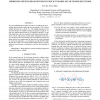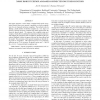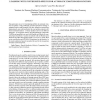ICASSP
2010
IEEE
13 years 11 months ago
2010
IEEE
In the EMIME project, we are developing a mobile device that performs personalized speech-to-speech translation such that a user’s spoken input in one language is used to produc...
ICASSP
2010
IEEE
13 years 11 months ago
2010
IEEE
We consider trellis-based algorithms for data estimation in digital communication systems. We present a general framework which includes approximate Viterbi algorithms like the M-...
ICASSP
2010
IEEE
13 years 11 months ago
2010
IEEE
Due to the ease with which convincing digital image forgeries can be created, a need has arisen for digital forensic techniques capable of detecting image manipulation. Once image...
ICASSP
2010
IEEE
13 years 11 months ago
2010
IEEE
In a paper published by Greenberg in 1998, it was said that in conversational speech, phone deletion rate may go as high as 12% whereas syllable deletion rate is about 1%. The fi...
ICASSP
2010
IEEE
13 years 11 months ago
2010
IEEE
This paper presents methods to improve retrieval of Out-OfVocabulary (OOV) terms in a Spoken Term Detection (STD) system. We demonstrate that automated tagging of OOV regions help...
ICASSP
2010
IEEE
13 years 11 months ago
2010
IEEE
ACT This works considers the problem of efficient energy allocation of resources in a continuous fashion in determining the location of targets in a sparse environment. We extend ...
ICASSP
2010
IEEE
13 years 11 months ago
2010
IEEE
Many sensor network related applications require precise knowledge of the location of constituent nodes. In these applications, it is desirable for the wireless nodes to be able t...
ICASSP
2010
IEEE
13 years 11 months ago
2010
IEEE
This paper proposes a noise robust exemplar-based speech recognition system where noisy speech is modeled as a linear combination of a set of speech and noise exemplars. The metho...
ICASSP
2010
IEEE
13 years 11 months ago
2010
IEEE
Class posterior distributions have recently been used quite successfully in Automatic Speech Recognition (ASR), either for frame or phone level classification or as acoustic featu...
ICASSP
2010
IEEE
13 years 11 months ago
2010
IEEE
Data sparseness is an ever dominating problem in automatic emotion recognition. Using artificially generated speech for training or adapting models could potentially ease this: t...



